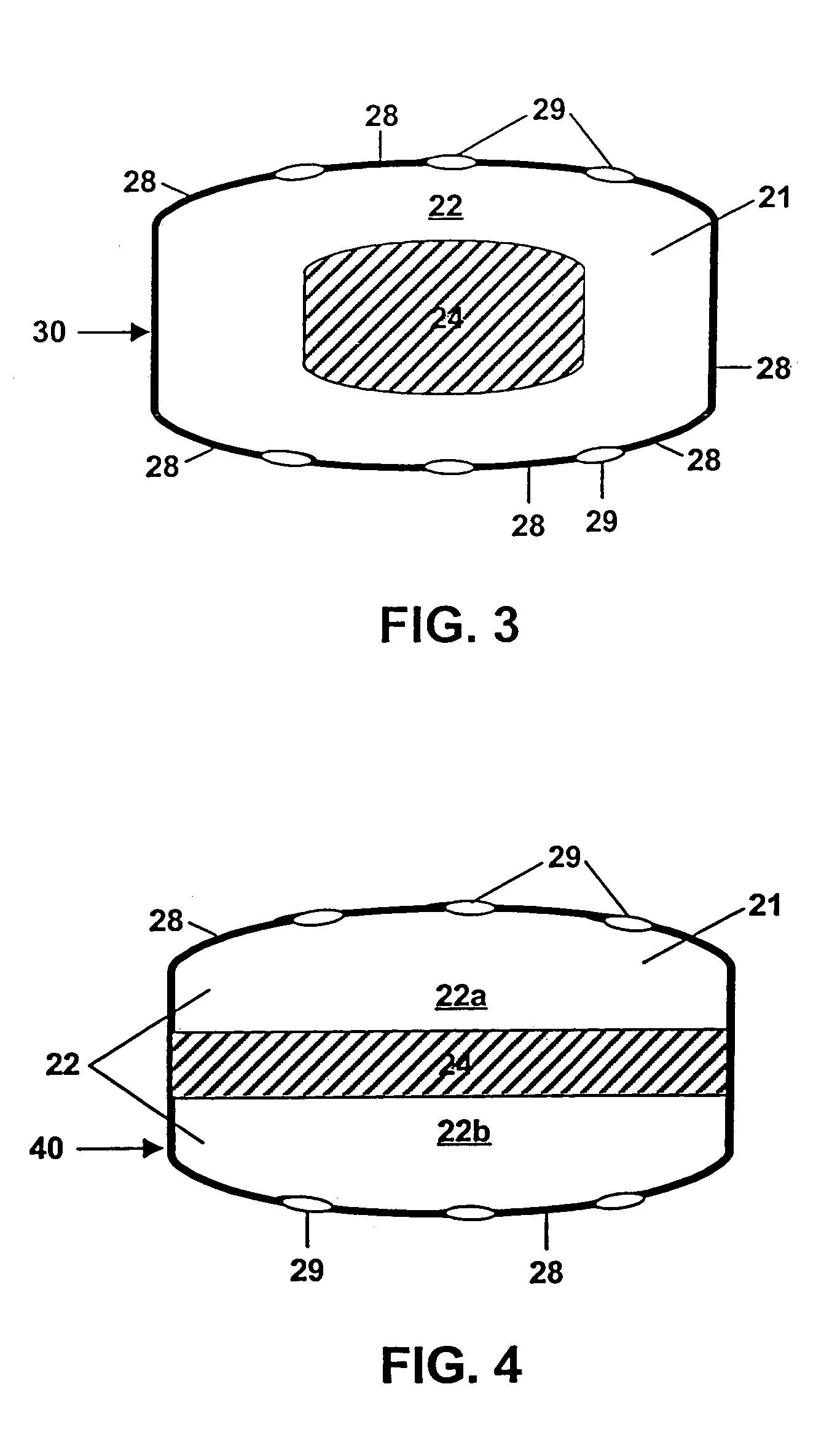Controlled release by extrusion of solid amorphous dispersions of drugs
a technology controlled release, which is applied in the direction of osmotic delivery, microcapsules, capsule delivery, etc., can solve the problems of poor bioavailability, poor drug delivery system, and limited success of solid amorphous dispersions in delivering poorly water-soluble drugs, and achieve low solubility
- Summary
- Abstract
- Description
- Claims
- Application Information
AI Technical Summary
Benefits of technology
Problems solved by technology
Method used
Image
Examples
example 1
[0092]Exemplary dosage-forms of the present invention comprising a batch of solid dispersion (“SD”) of 10 wt % sparingly soluble drug and 90 wt % polymer was made by mixing the drug [R-(R*,S*)]-5-chloro-N-[2-hydroxy-3-[methoxymethylamino)-3-1-(phenylmethyl)propyl]propyl]-1H-indole-2-carboxamide (a glycogen phosphorylase inhibitor) (hereinafter referred to as “Drug 1”) having a water solubility of 1 μg / mL, in the solvent acetone together with a “medium fine” (MF) grade of HPMCAS (AQUOT, Shinetsu, Tokyo, Japan) to form a solution. The solution comprised 0.27 wt % Drug 1, 2.43 wt % polymer and 97.3 wt % solvent. This solution was then spray-dried by directing an atomizing spray via a rotary atomizer at 18 psi and a 100 g / min feed rate into a stainless steel chamber of a Niro portable spray-dryer maintained at 120° C. at the inlet and 68° C. at the outlet. Portions of the dispersion were held back and subjected to powder X-ray diffraction analysis and so verified the drug to be in an es...
example 2
[0100]A solid amorphous dispersion comprising 33.3 wt % of a different glycogen phosphorylase inhibitor, namely 5-chloro-1H-indole-2-carboxylic acid[1S)-benzyl-3-((3R,4S)-dihydroxypyrrolidin-1-yl-)-(2R)-hydroxy-3-oxypropyl]amide (“Drug. 2”) having a water solubility of 80 μm / mL and 66.7 wt % of the same grade of HPMCAS used in Example 1 was prepared in substantially the same way as in Example 1 except as follows: concentrations of drug and polymer in the spray solution were at 2.5 wt % and 5.0 wt %, respectively; the inlet temperature was 179° C. and the outlet temperature was 70° C.; the feed rate was 200 g / min and a 2-fluid nozzle was used. The solid dispersion thus formed was mixed with the other tableting excipients as in Example 1 such that the final composition was 28 wt % solid drug dispersion, 22 wt % xylitol containing 1.5 wt % CMC (XYLITAB 200, American Xyrofin, Shaumberg, Ill.), 29 wt % PEO having an average MW of 600,000 daltons, 20 wt % of the osmopolymer sodium starch ...
example 3
[0106]This example illustrates the inventive delivery of Drug 2 except that the core of the tablet was a “trilayer” design of the type depicted in FIG. 4. The core comprised two compositions; a sweller layer between two essentially identical drug layers. The drug was in the form of a solid dispersion of identical composition to that of Example 2. The drug layers were composed of 26.25 wt % solid dispersion, 35 wt % XYLITAB 200, 32.5 wt % PEO with an average MW of 600,000 daltons, 5.0 wt % EXPLOTAB and 1.25 wt % magnesium stearate. The sweller layer was composed of 74 wt % EXPLOTAB, 25 wt % PROSOLV go and 1 wt % magnesium stearate. Tablets were formed by first mechanically mixing the above drug layer ingredients until homogeneous, compressing to a hardness of 4 Kponds and then milling to a size of 800 μm or less. 200 mg of the drug layer mixture were then placed into the bottom of a standard 3 / 8-inch die and lightly tamped. Then 100 mg of the sweller layer mixture was placed in the d...
PUM
| Property | Measurement | Unit |
|---|---|---|
| Dispersion potential | aaaaa | aaaaa |
| Concentration | aaaaa | aaaaa |
| Solubility (mass) | aaaaa | aaaaa |
Abstract
Description
Claims
Application Information
 Login to View More
Login to View More - R&D
- Intellectual Property
- Life Sciences
- Materials
- Tech Scout
- Unparalleled Data Quality
- Higher Quality Content
- 60% Fewer Hallucinations
Browse by: Latest US Patents, China's latest patents, Technical Efficacy Thesaurus, Application Domain, Technology Topic, Popular Technical Reports.
© 2025 PatSnap. All rights reserved.Legal|Privacy policy|Modern Slavery Act Transparency Statement|Sitemap|About US| Contact US: help@patsnap.com



